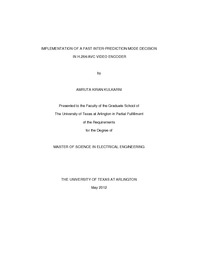
ATTENTION: The works hosted here are being migrated to a new repository that will consolidate resources, improve discoverability, and better show UTA's research impact on the global community. We will update authors as the migration progresses. Please see MavMatrix for more information.
Show simple item record
| dc.contributor.author | Kulkarni, Amruta Kiran | en_US |
| dc.date.accessioned | 2012-07-25T19:10:03Z | |
| dc.date.available | 2012-07-25T19:10:03Z | |
| dc.date.issued | 2012-07-25 | |
| dc.date.submitted | January 2012 | en_US |
| dc.identifier.other | DISS-11649 | en_US |
| dc.identifier.uri | http://hdl.handle.net/10106/11109 | |
| dc.description.abstract | H.264/MPEG-4 Part 10 or AVC (advanced video coding) is currently one of the most widely used industry standards for video compression. There are several video codec solutions, both software and hardware, available in the market for H.264. This video compression technology is primarily used in applications such as video conferencing, mobile TV, blu-ray discs, digital television and internet video streaming. This thesis uses the JM 17.2 reference software [15], which is available for all users and can be downloaded from http://iphome.hhi.de/suehring/tml. The software is mainly used for educational purposes; it also includes the reference software manual which has information about installation, compilation and usage. In real time applications such as video streaming and video conferencing it is important that the video encoding/decoding is fast. It is known, that most of the complexity lies in the H.264 encoder, specifically the motion estimation (ME) and mode decision process introduces high computational complexity and takes a lot of CPU (central processing unit) usage. The mode decision process is complex because of variable block sizes (16X16 to 4x4) motion estimation and half and quarter pixel motion compensations. Hence, the objective of this thesis is to reduce the encoding time while maintaining the same quality and efficiency of compression. The Fast adaptive termination (FAT) [30] algorithm is used in the mode decision and motion estimation process. Based on the rate-distortion (RD) cost characteristics all the inter modes are classified as either skip modes or non-skip modes. In order to select the best mode for any macroblock, the minimum RD cost of these two modes is predicted. Further, for skip mode, an early-skip mode detection test is proposed; for non-skip mode a three-stage scheme is proposed to speed up the mode decision process. Experimental results demonstrate that the proposed technique has good robustness in coding efficiency with different quantization parameters (QP) and various video sequences. It is able to achieve encoding time saving by 47.6% and loss of only 0.01% decrease in structural similarity index matrix (SSIM) with negligible degradation in peak signal to noise ratio (PSNR) and acceptable increase in bit rate. | en_US |
| dc.description.sponsorship | Rao, Kamisetty R. | en_US |
| dc.language.iso | en | en_US |
| dc.publisher | Electrical Engineering | en_US |
| dc.title | Implementation Of Fast Inter-prediction Mode Decision In H.264/AVC Video Encoder | en_US |
| dc.type | M.Engr. | en_US |
| dc.contributor.committeeChair | Rao, Kamisetty R. | en_US |
| dc.degree.department | Electrical Engineering | en_US |
| dc.degree.discipline | Electrical Engineering | en_US |
| dc.degree.grantor | University of Texas at Arlington | en_US |
| dc.degree.level | masters | en_US |
| dc.degree.name | M.Engr. | en_US |
Files in this item
- Name:
- Kulkarni_uta_2502M_11649.pdf
- Size:
- 2.183Mb
- Format:
- PDF
This item appears in the following Collection(s)
Show simple item record


